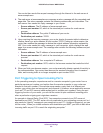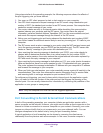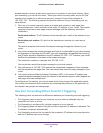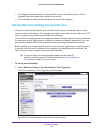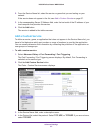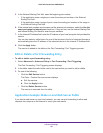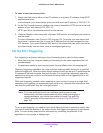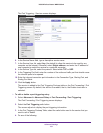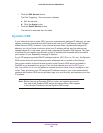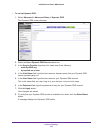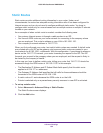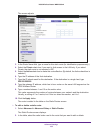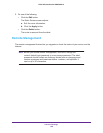
Advanced Settings
99
N300 Wireless Router WNR2000v4
To make a local web server public:
1. Assign your web server either a fixed IP address or a dynamic IP address using DHCP
address reservation.
In this example, your router always gives your web server an IP address of 192.168.1.33.
2. On the Port Forwarding screen, configure the router to forward the HTTP service to the local
address of your web server at 192.168.1.33.
HTTP (port 80) is the standard protocol for web servers.
3. (Optional) Register a host name with a Dynamic DNS service, and configure your router to
use the name.
For more information, see Dynamic DNS on page 102. To access your web server from
the Internet, a remote user has to know the IP address that has been assigned by your
ISP. However, if you use a Dynamic DNS service, the remote user can reach your server
by a user-friendly Internet name, such as mynetgear.dyndns.org.
Set Up Port Triggering
Port triggering is a dynamic extension of port forwarding that is useful in these cases:
• More than one local computer needs port forwarding for the same application (but not
simultaneously).
• An application needs to open incoming ports that are different from the outgoing port.
When port triggering is enabled, the router monitors outbound traffic looking for a specified
outbound trigger port. When the router detects outbound traffic on that port, it remembers the
IP address of the local computer that sent the data. The router then temporarily opens the
specified incoming port or ports, and forwards incoming traffic on the triggered ports to the
triggering computer.
While port forwarding creates a static mapping of a port number or range to a single local
computer, port triggering can dynamically open ports to any computer that needs them and
can close the ports when they are no longer needed.
Note: If you use applications such as multiplayer gaming, peer-to-peer
connections, real-time communications such as instant messaging, or
remote assistance, you should also enable Universal Plug and Play
(UPnP) according to the instructions in
Universal Plug and Play on
page 108.
To set up port triggering, you need to know which inbound ports the application needs. Also,
you need to know the number of the outbound port that triggers the opening of the inbound
ports. You can usually determine this information by contacting the publisher of the
application or user groups or newsgroups.





